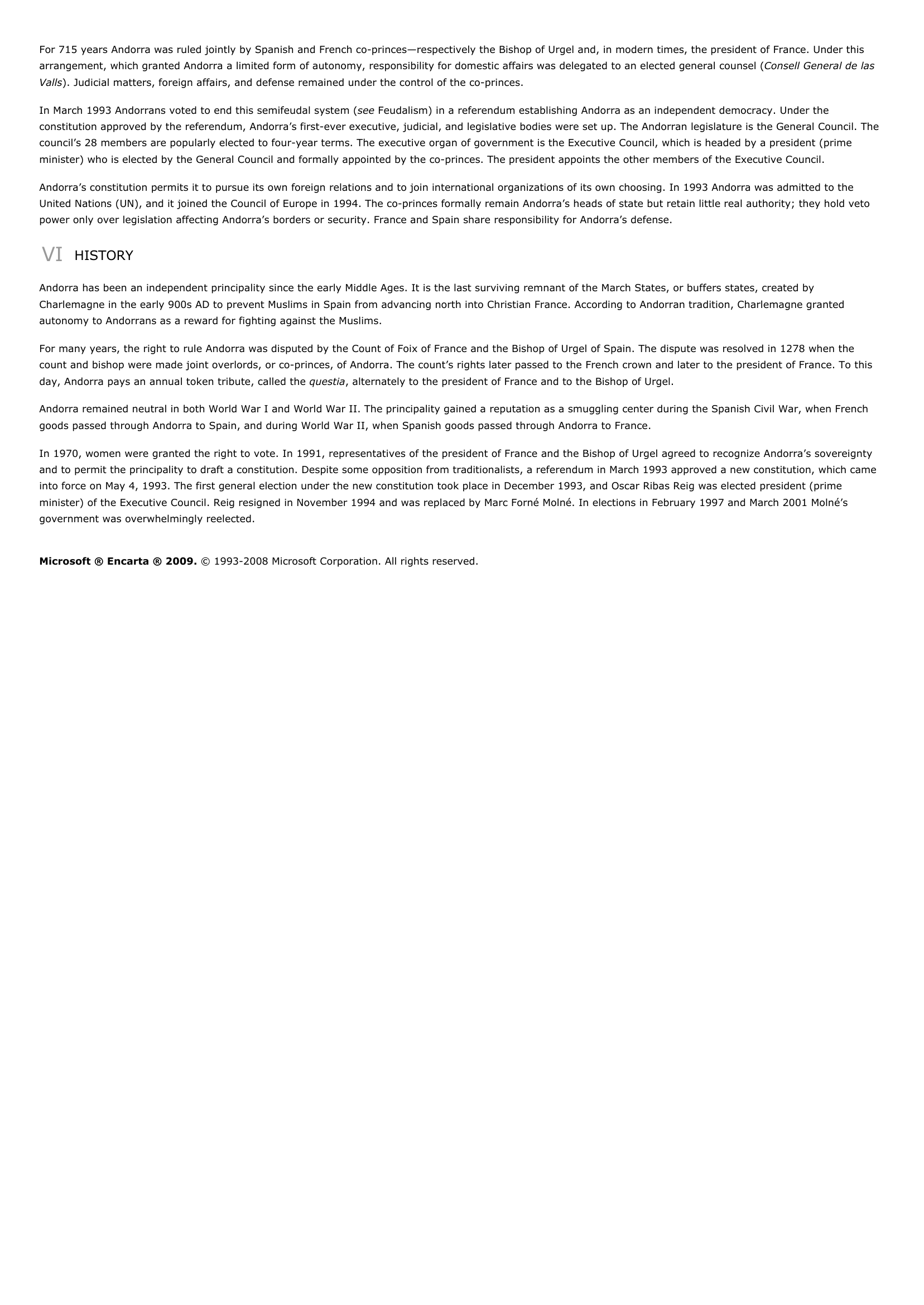Andorra - country.
Publié le 04/05/2013

Extrait du document
«
For 715 years Andorra was ruled jointly by Spanish and French co-princes—respectively the Bishop of Urgel and, in modern times, the president of France.
Under thisarrangement, which granted Andorra a limited form of autonomy, responsibility for domestic affairs was delegated to an elected general counsel ( Consell General de las Valls ).
Judicial matters, foreign affairs, and defense remained under the control of the co-princes.
In March 1993 Andorrans voted to end this semifeudal system ( see Feudalism) in a referendum establishing Andorra as an independent democracy.
Under the constitution approved by the referendum, Andorra’s first-ever executive, judicial, and legislative bodies were set up.
The Andorran legislature is the General Council.
Thecouncil’s 28 members are popularly elected to four-year terms.
The executive organ of government is the Executive Council, which is headed by a president (primeminister) who is elected by the General Council and formally appointed by the co-princes.
The president appoints the other members of the Executive Council.
Andorra’s constitution permits it to pursue its own foreign relations and to join international organizations of its own choosing.
In 1993 Andorra was admitted to theUnited Nations (UN), and it joined the Council of Europe in 1994.
The co-princes formally remain Andorra’s heads of state but retain little real authority; they hold vetopower only over legislation affecting Andorra’s borders or security.
France and Spain share responsibility for Andorra’s defense.
VI HISTORY
Andorra has been an independent principality since the early Middle Ages.
It is the last surviving remnant of the March States, or buffers states, created byCharlemagne in the early 900s AD to prevent Muslims in Spain from advancing north into Christian France.
According to Andorran tradition, Charlemagne grantedautonomy to Andorrans as a reward for fighting against the Muslims.
For many years, the right to rule Andorra was disputed by the Count of Foix of France and the Bishop of Urgel of Spain.
The dispute was resolved in 1278 when thecount and bishop were made joint overlords, or co-princes, of Andorra.
The count’s rights later passed to the French crown and later to the president of France.
To thisday, Andorra pays an annual token tribute, called the questia , alternately to the president of France and to the Bishop of Urgel.
Andorra remained neutral in both World War I and World War II.
The principality gained a reputation as a smuggling center during the Spanish Civil War, when Frenchgoods passed through Andorra to Spain, and during World War II, when Spanish goods passed through Andorra to France.
In 1970, women were granted the right to vote.
In 1991, representatives of the president of France and the Bishop of Urgel agreed to recognize Andorra’s sovereigntyand to permit the principality to draft a constitution.
Despite some opposition from traditionalists, a referendum in March 1993 approved a new constitution, which cameinto force on May 4, 1993.
The first general election under the new constitution took place in December 1993, and Oscar Ribas Reig was elected president (primeminister) of the Executive Council.
Reig resigned in November 1994 and was replaced by Marc Forné Molné.
In elections in February 1997 and March 2001 Molné’sgovernment was overwhelmingly reelected.
Microsoft ® Encarta ® 2009. © 1993-2008 Microsoft Corporation.
All rights reserved..
»
↓↓↓ APERÇU DU DOCUMENT ↓↓↓
Liens utiles
- Placed under the dual sovereignty of the bishop of Urgel and the President of the French Republic, Andorra is the highest inhabited country in Europe.
- LA MUSIQUE COUNTRY
- Country- und Western-Musik - Musik.
- Pays noir, en anglais Black Country, terme imagé désignant les régions industrielles fondées sur l'extraction du charbon depuis l'époque de la révolution industrielle.
- Miembros de Naciones Unidas Afganistán Etiopía Nepal Albania Islas Fiji Nicaragua Alemania Filipinas Níger Andorra Finlandia Nigeria Angola Francia Noruega Antigua y Barbuda Gabón Nueva Zelanda Arabia Saudí Gambia Omán Argelia Georgia Países Bajos Argentina Ghana Pakistán Armenia Granada Palau Australia Grecia Panamá Austria Guatemala Papúa-Nueva




